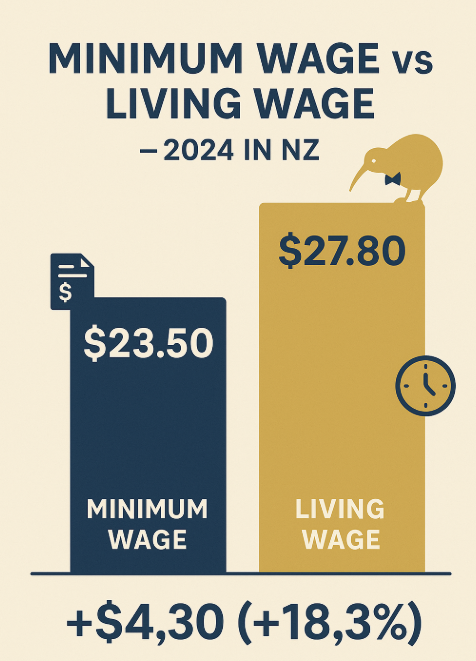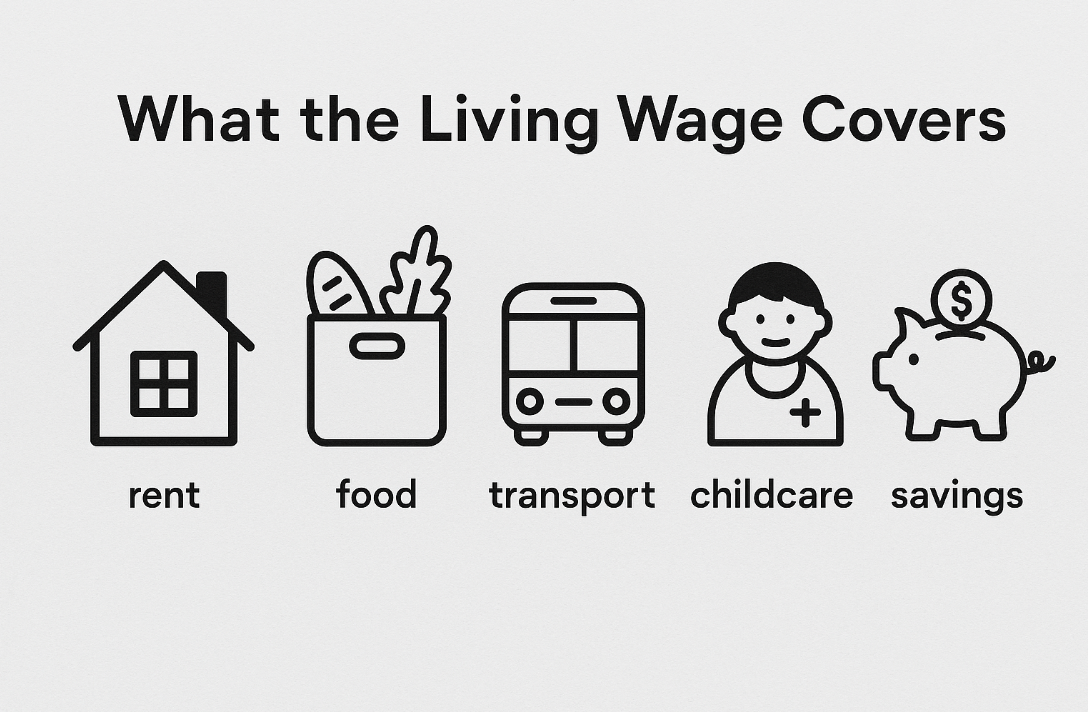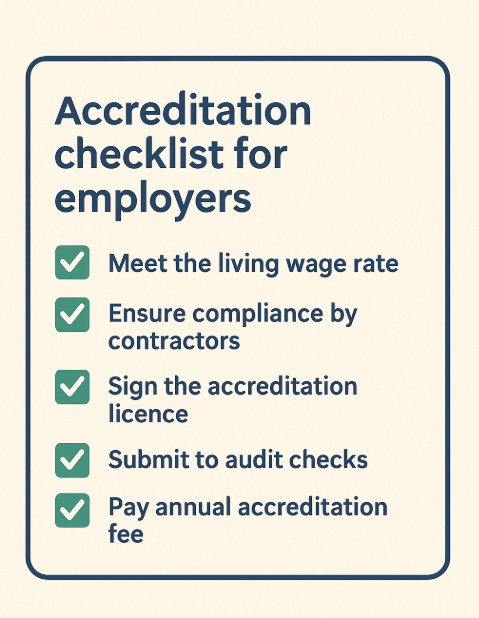So, what is Living Wage NZ? Good question. Especially if you’ve ever worked your butt off and still found yourself short on rent, petrol, or a Friday night beer.
Most people think it’s just another word for the minimum wage. It’s not. The Living Wage is what you actually need to earn to live—not just survive on two-minute noodles and second-hand socks. It’s calculated every year based on what it costs to be a human being in Aotearoa with, you know… basic dignity.
Right now, the 2025 Living Wage rate is going up (again), and if you’re an employer, employee, or just curious about where your paycheque sits, this article will clear it up.
You’ll get the facts, the current rate, how it’s calculated, how to become an accredited Living Wage employer, and—yes—even how it compares to the legal stuff. Spoiler alert: it’s higher. Let’s unpack it all and figure out whether this thing is just a buzzword or something worth caring about.
Current living wage NZ 2025 rate (definition + update)
Let’s start with the basics—what is the Living Wage in NZ right now, and who decides it? Spoiler: it’s not the Government. The Living Wage Movement Aotearoa is the group behind the rate, and their mission is simple: set a number that reflects the real cost of life in New Zealand.
2024/25 rate recap
Before we talk 2025, here’s a quick throwback to the current living wage NZ 2024/25:
$27.80 per hour. That’s the amount many accredited employers have been working with up until now.
It’s already well above the minimum wage ($23.50/hour), and that gap? It matters—a lot. Especially if you’re working full-time and still feeling broke halfway through the week.

2025/26 increase to $28.95/hour
From 1 September 2025, the Living Wage increases to $28.95/hour. That’s a jump of $1.15.
This new rate applies to all accredited Living Wage employers and covers directly employed staff as well as regular contractors. You can read the full announcement on the official Living Wage Movement website.
To put it bluntly: if you’re earning this rate, you’re doing better than hundreds of thousands of other Kiwi workers.
How the Living Wage is calculated in NZ
This isn’t a number pulled out of thin air. The Living Wage in New Zealand is based on actual household expenses—costs that real people face every single day.
It’s updated annually through a review process that factors in inflation, rent, power bills, transport, and more.
Key cost components
These are the core things used to calculate the rate:
- Rent and utilities
- Food and groceries
- Public transport and car expenses
- Childcare and school costs
- Clothing, healthcare, and basic savings
In short: if it’s essential, it’s part of the equation.

Annual review process by Living Wage Movement
Every year, an independent panel crunches the data. They use research from BERL (Business and Economic Research Ltd) and take a hard look at household budgets. This is where the Living Wage Movement Aotearoa earns its stripes.
To dig deeper into the methodology, check out BERL’s cost of living breakdown.
Living wage vs minimum wage in NZ: key differences
Here’s where things get interesting. The Living Wage is voluntary. The minimum wage is legal. But the difference between them? It’s more than just a few bucks.
If you’ve ever tried to budget on $23.50/hour in Auckland or Wellington, you’ll know exactly what we’re talking about.
Summary table: comparing both wages
| Financial year | Living wage | Minimum wage | Difference | % gap |
|---|---|---|---|---|
| 2024/25 | $27.80 | $23.50 | $4.30 | 18.3% |
| 2025/26 | $28.95 | $23.50* | $5.45 | 23.2% |
- Assuming no increase in the minimum wage for 2025/26.
This is what people mean when they say the minimum wage isn’t enough to “get by.”
Cost-to-employer vs staff retention
Paying the Living Wage may cost a business more upfront—but it pays off.
Here’s why:
- Staff are more likely to stay
- Productivity goes up
- Recruitment costs go down
- Workers are healthier and less stressed
Why pay the living wage? Benefits for workers & businesses
Still on the fence? Let’s be honest—most businesses that don’t pay the Living Wage think it’s “too expensive.” But research says otherwise.
For employers, it’s not just about being nice. It’s smart business.
- More motivated staff = better customer service
- Lower turnover = less training time
- Public trust = stronger brand reputation
- Accreditation badge = a competitive edge for contracts
Bullet points: benefits for both sides
For workers:
- Less financial stress
- Ability to save or pay down debt
- Dignity and independence
For employers:
- Better team morale
- Lower absenteeism
- Competitive advantage in hiring
There’s also the community factor—when workers earn enough to live, they spend more locally. That’s good for everyone.
How to become an accredited Living Wage employer in NZ
So you’re convinced? Great. Let’s talk about getting Living Wage accreditation in NZ.
This isn’t a huge bureaucratic mess—it’s actually a straightforward process that shows your staff (and your clients) that you’re serious about fair pay.
Eligibility & core/contractor coverage
To be accredited, you must:
- Pay all directly employed staff the Living Wage
- Extend that rate to regular contractors (e.g. cleaners, security)
- Provide evidence (e.g. payslips, contracts)
Application steps & verification

Here’s how it works:
- Fill out the application on livingwage.org.nz
- Submit documents proving compliance
- Commit to updating wages annually
- Get listed as an accredited employer
Once approved, you’ll be listed publicly—yep, there’s an actual Living Wage Employers list. That’s a nice bit of PR.
Maintaining compliance year-on-year
Every year, your business needs to:
- Adjust pay rates to meet the updated Living Wage
- Reconfirm your contractor arrangements
- Renew your accreditation certificate
Simple enough, especially for what you get in return: loyal staff, good press, and a genuine point of difference in a crowded market.
Bonus for what is living wage NZ
Here’s a quick hit of extra value:
- Try this Living Wage calculator (from the Movement’s site) to estimate staff impact
- Download the Living Wage employer toolkit (PDF guide)
- Use wage discussions to boost employee engagement—talk openly about value, cost of living, and fairness
Pro tip: Want to pay fairly but don’t know where to start? Reach out to BH Accounting for a chat—we can connect you with the right advisor.
Conclusion
The Living Wage in NZ isn’t just a number. It’s a mindset. Whether you’re earning it, paying it, or aiming for it, it’s about treating people like humans—not line items.
This article broke down the 2025 rate, the difference from minimum wage, how it’s calculated, and why it matters for employers and workers alike.
Ready to take the next step? Ask your boss if they’ve heard of the Living Wage—or better yet, become the kind of business that leads by example.
FAQ about what is living wage NZ
Is the Living Wage mandatory in New Zealand?
Nope. It’s a voluntary rate. Only the minimum wage is enforced by law. But more employers are stepping up and paying the Living Wage.
Who sets the Living Wage in NZ?
The rate is set by the Living Wage Movement Aotearoa, based on data from BERL and other cost-of-living research.
Do part-time or casual workers qualify?
If you’re working for an accredited Living Wage employer, yes. As long as you’re doing regular hours, you should be covered.
Can businesses lose accreditation?
Yes. If they stop paying the updated rate or fail to cover contractors, they can be removed from the official employer list.
Is the Living Wage rate the same across New Zealand?
Yes—it’s a national rate, even though the cost of living varies. The goal is to set a fair average across the country.
